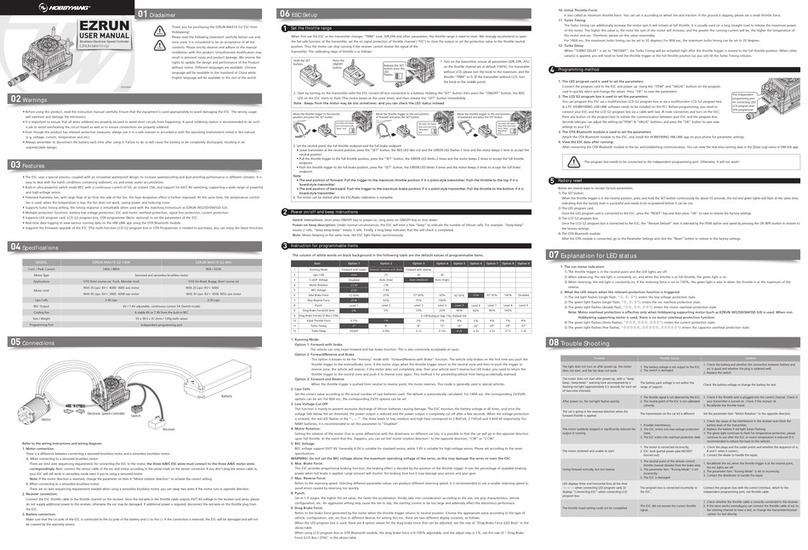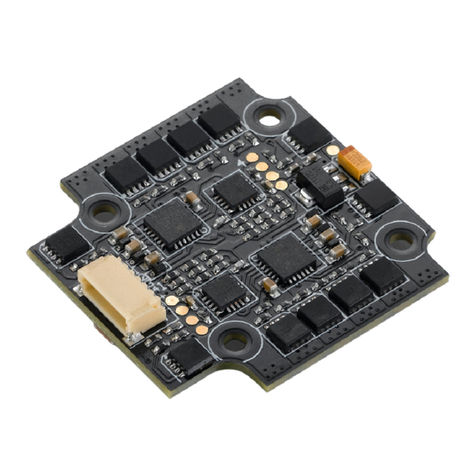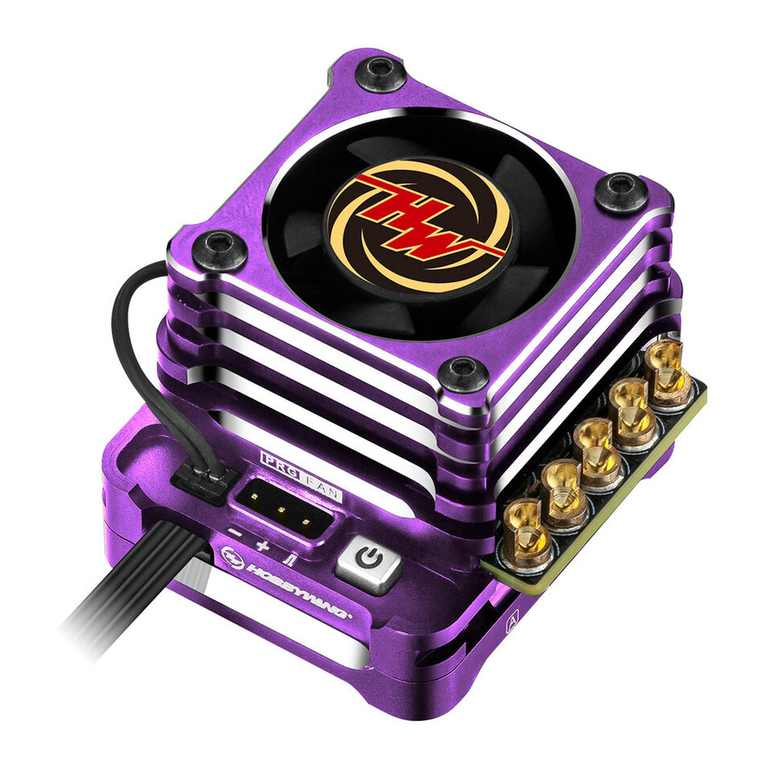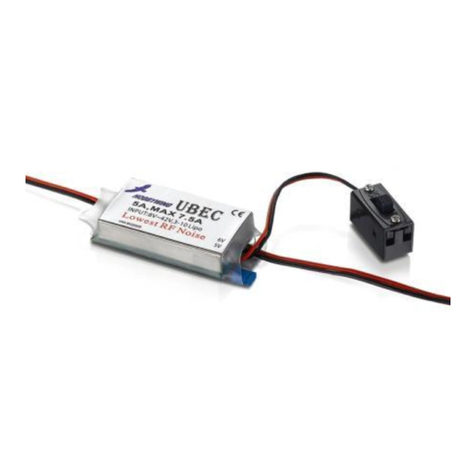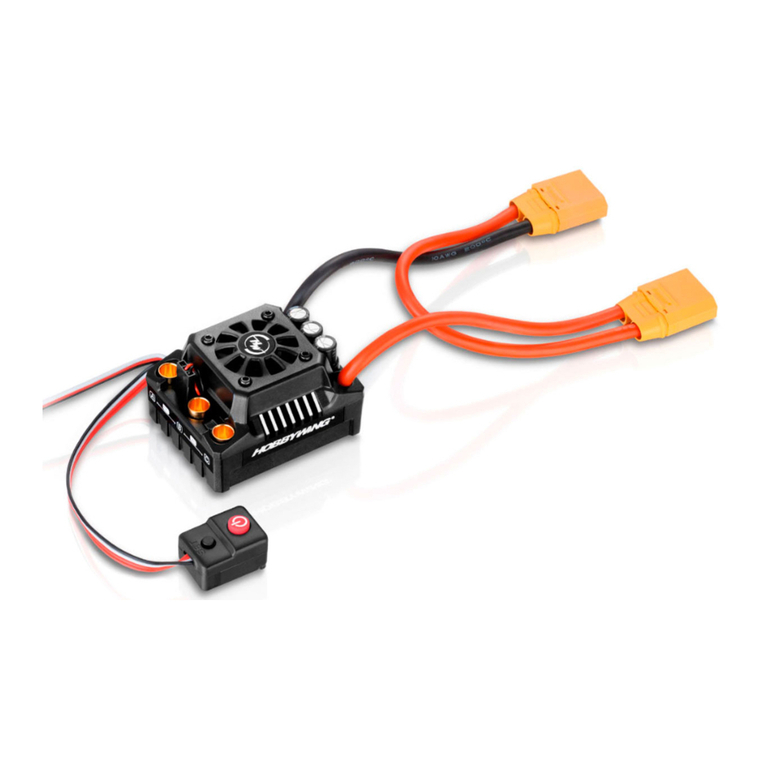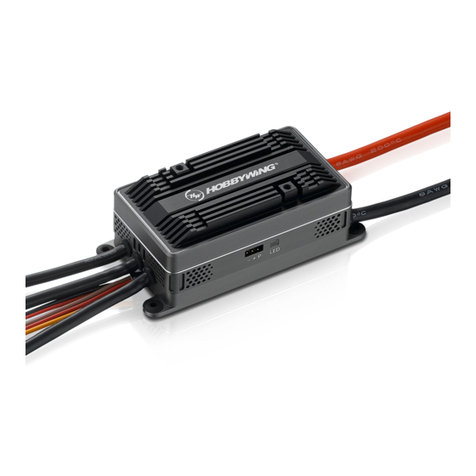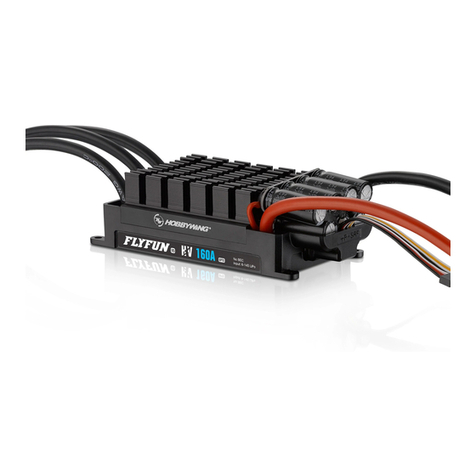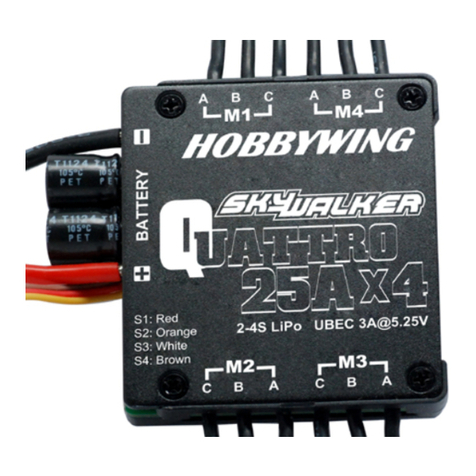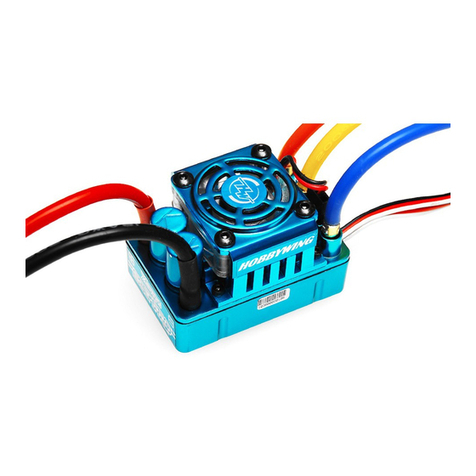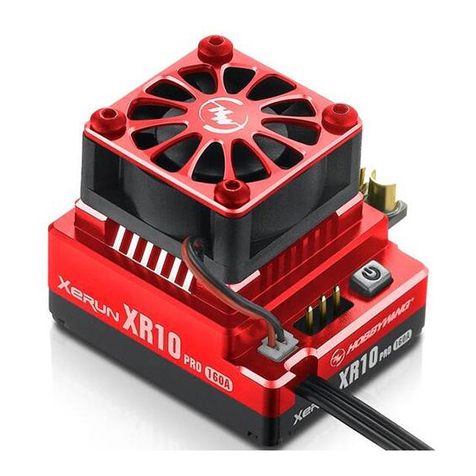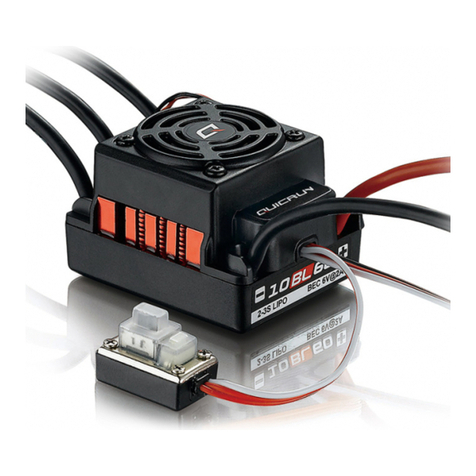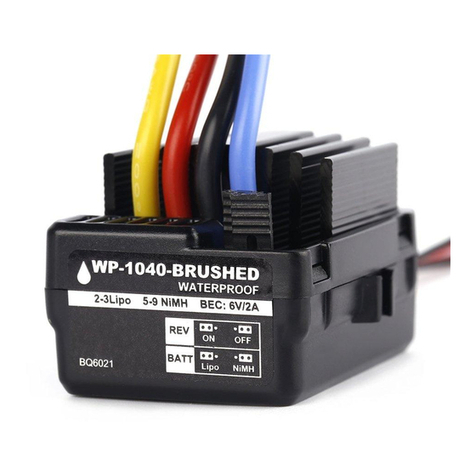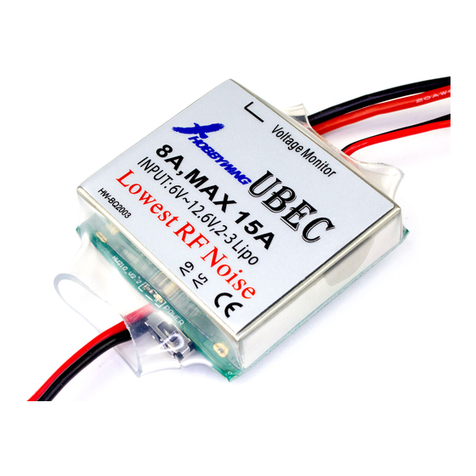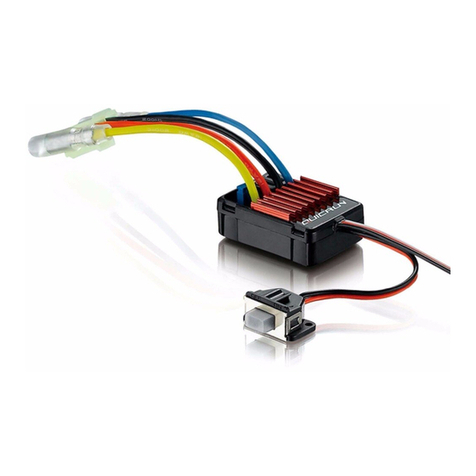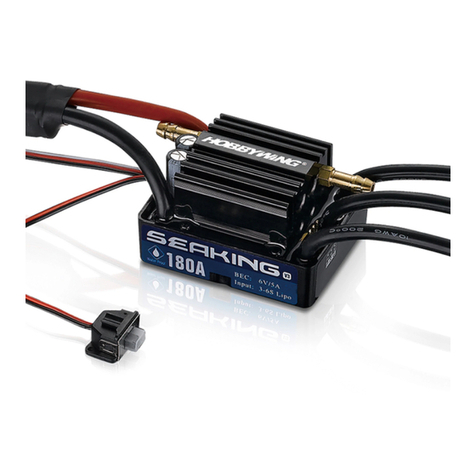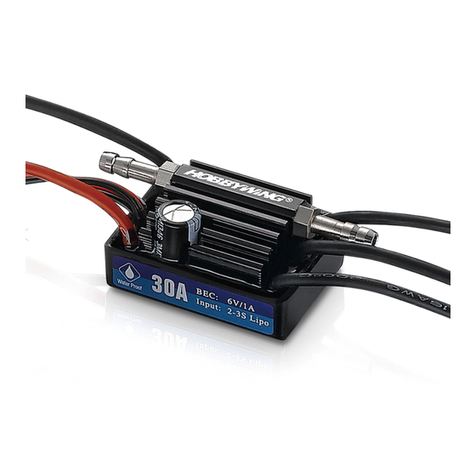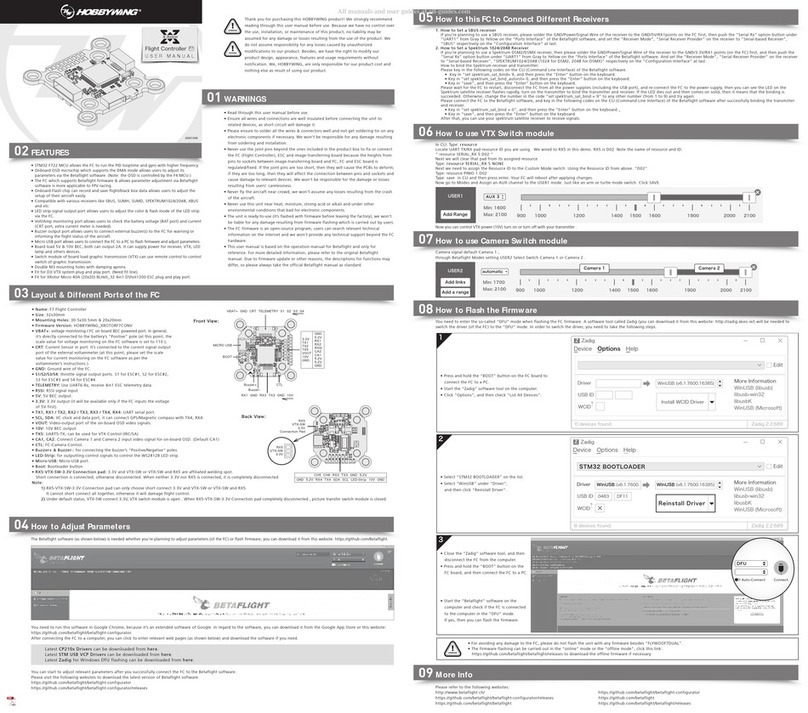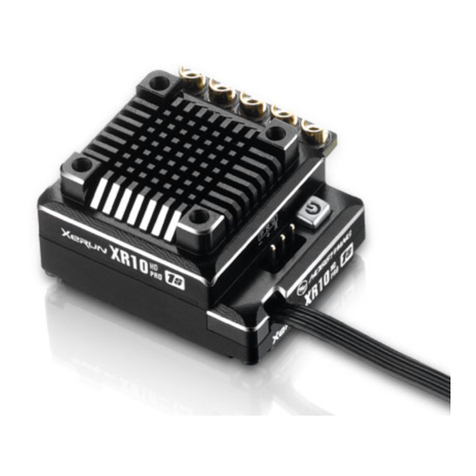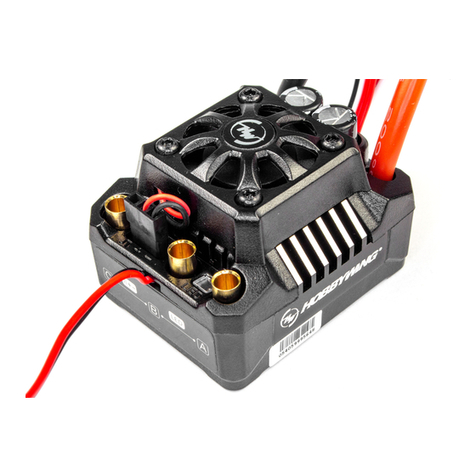
Trouble(s) Solution(s)Possible Causes
1. No power was supplied to the ESC.
2. The ESC switch was damaged.
The throttle cable was reversely plugged into
the TH channel or plugged into wrong channel on the receiver.
1. The (ESC-to-motor) wiring order was incorrect.
2. Your chassis is different from popular chassis.
1. The receiver was influenced by some foreign interference.
2. The ESC entered the LVC protection.
3. The ESC entered the thermal shutdown protection.
1. The throttle neutral position on your transmitter
was actually in the braking zone.
2.Setthe“RunningMode”improperly.3. The ESC was damaged.
1. Some soldering between the motor and the ESC
was not good.
2. The ESC was damaged (some MOSFETS were burnt). CheckifallESC&batteryconnectorshavebeenwellsolderedorfirmly connected.
Plug the throttle cable into the throttle channel (CH2) by referring to
relevant mark shown on your receiver.
1. Swap any two (ESC-to-motor) wires if you are using a sensorless motor.
2. There is nothing you can do if you are using a sensored motor and your
chassis is different from popular chassis.
1. Check all devices and try to find out all possible causes, and check the
transmitter’s battery voltage.
2. The RED LED keeps flashing indicating the LVC protection is activated,
please replace your pack.
3. The GREEN LED keeps flashing indicating the thermal protection is
activated, please let your ESC cool down before using it again.
1. Recalibrate the throttle neutral position. No LED on the ESC will come
on when the throttle trigger is at the neutral position.
2.Setthe“RunningMode”to“Fwd/RevwithBrk“.3. Contact the distributor for repair or other customer service.
1. Check all soldering points, please re-solder if necessary.
2. Contact the distributor for repair or other customer service.
1. Change another pack with great discharging capability.
2. Change a low-speed motor, or increase the FDR.
3. Set the punch/start mode to a low level.
1. Check if the sensor cable is loose or poor contact issue exists.
2. Hall sensor inside the motor is damaged.
The ESC was unable to start the motor, but the
RED LED on the ESC turned on solid.
The vehicle ran backward when you pulled the
throttle trigger towards you.
The ESC was unable to start the status LED, the
motor, and the cooling fan after it was powered on.
The motor stuttered but couldn’t start.
The vehicle could run forward (and brake),
but could not reverse.
The motor got stuck or stopped when increasing
the throttle during the starting-up process.
TheRED&GREENLEDSontheESCflashedrapidlyat the same time when the throttle trigger was at
the neutral position.
The motor suddenly stopped or significantly
reduced the output in operation.
1. Poor discharging capability of the pack.
2. The RPM of the motor was too high, or the FDR
was too low.
3. Set the "Punch/Start Mode" to a high level.
(When pairing with a sensored motor) the ESC
automatically switched to sensorless mode
when it detected incorrect signal from Hall sensor.
1. Check if the wiring order is A-A, B-B, and C-C.
2. Contact the distributor for repair or other customer service.
The motor stuttered but couldn’t start. 1. The (ESC-to-motor) wiring order was incorrect.
2. The ESC was damaged.
08
Trouble Shooting
09
Guidance
Option 2: Auto
In Auto mode, the ESC adjusts the Boost Timing dynamically as per the throttle amount. Only at full throttle, the actual Boost Timing is the value you had previously set.
4C. Boost Start RPM
This item defines the RPM at which Boost Timing is activated. For example, when the Boost Start RPM is set to 5000, the ESC will activate the corresponding Boost Timing when the
RPM goes above 5000. The specific value is determined by the Boost Timing and the Boost End RPM you had previously set.
4D. Boost End RPM
This item defines the RPM at which Boost Timing (you specifically set) is applied. For example, when Boost Timing is set to 10 degrees and the Boost End RPM to 15000, the ESC will
activate the Boost Timing of 10 degrees when the RPM goes above 15000. The ESC will adjust the Boost Timing accordingly as per the actual RPM when the RPM goes below 15000.
5A. Turbo Timing
This item is adjustable from 0 degree to 64 degrees, the corresponding turbo timing (you set) will initiate at full throttle. It’s usually activated on long straightaway and makes the
motor unleash its maximum potential.
5B. Turbo Delay
When“TURBODELAY”issetto“INSTANT”,theTurboTimingwillbeactivatedrightafterthethrottletriggerismovedtothefullthrottleposition.Whenothervalue(s)isapplied,
you will need to hold the throttle trigger at the full throttle position (as you set) till the Turbo Timing initiates.
5C. Turbo Increase Rate
Thisitemisusedtodefinethe“speed”atwhichTurboTimingisreleasedwhenthetriggerconditionismet.Forexample,“6degs/0.1sec”referstotheTurboTimingof6degreesthatwillbereleasedin0.1second.Boththeaccelerationandheatishigherwhenthe“Turboincreaserate”isofalargervalue.5D. Turbo Decrease Rate
After the Turbo Timing is activated and the trigger condition turns to not be met (i.e. vehicle slows down at the end of the straightaway and gets into a corner, full throttle turns to
partial throttle, the trigger condition for Turbo Timing turns to be not met), if you disable all the Turbo Timing in a moment, an obvious slow-down like braking will be felt and cause
thecontrolofvehicletobecomebad.IftheESCcandisabletheTurboTimingatsome“speed”,theslow-downwillbelinearandthecontrolwillbeimproved.Warning!BoostTiming&TurboTimingcaneffectivelyimprovethemotorefficiency;theyareusuallyusedincompetitions.Pleasetakesometimetoreadthismanualandthensetthesetwoitemscarefully,monitortheESC&motortemperatureswhenyouhaveatrialrunandthenadjusttheTimingandFDRaccordinglyasaggressiveTimingsandFDRmaycauseyour ESC or motor to be burnt.
1) Program your ESC with a multifunction LCD program box
YoucanprogramthisXR10STOCKSPECESCviaamultifunctionLCDprogramboxorviaamultifunctionLCDprogrambox&aPC(HOBBYWINGUSBLINKsoftwareneedstobeinstalled on the PC). Before programming, you need to connect your ESC and the LCD program box via a cable with two JR male connectors and turn on the ESC; the boot
screenwillshowupontheLCD.PressanybuttonontheprogramboxtoinitiatethecommunicationbetweenyourESCandtheprogrambox.Secondslater,“CONNECTINGESC”willbedisplayed,andindicatesthefollowingparameters.Youcanadjustthesettingvia“ITEM”&“VALUE”buttons,andpressthe“OK”buttontosavenewsettingstoyour ESC.
2) Program your ESC with a WiFi Module
The XR10 STOCK SPEC ESC can also be programmed via a WiFi module along with smart phone devices (HOBBWYING WiFi LINK software
needs to be installed on the smart phone). Before programming, users will need to plug the programming cable on the WiFi module into the
programming port on ESC and switch on the ESC. For detailed information about ESC programming via WiFi module, please refer to the
user manual of Hobbywing’s WiFi Express.
Attention! This ESC has a separate programming port. Please don’t use the throttle control cable (also called Rx cable) on the ESC to
connect the program box; otherwise the program box won’t function.
3) Data Checking
The ESC is able to record the maximum ESC temperature, maximum motor temperature, minimum battery voltage and maximum motor speed in operation. It automatically saves
the recorded data to the designated area when you turn off the ESC after a run. You can check those data via a multifunction LCD program box whenever necessary.
UsersneedtoswitchontheESCafterconnectionbetweentheprogramboxandtheESChasbeenestablished.Pressthe“R/P”buttononany“item”pagefollowedbypressingthe“R/P”buttonagainmultipletimes.Thefollowing5itempageswillbedisplayedcircularly:Mode→ESC Temperature→Motor Temperature →Min Voltage→Max RPM.
Attention!
•Pressthe“VALUE”buttononanydata-recordingpagecangetyouintothenextpresetmode.Pleasenotethatimproperoperationwillgetyouintootherpresetmode(s).•Pressthe“ITEM”buttononanydata-recordingpagecangetyoutotheparametersettingpageofthecurrentpresetmode;pressthe“R/P”buttonifyouwanttoreturntothe data-recording page
07
Explanation for LED Status
1. During the Start-up Process
•The RED LED turns on solid indicating the ESC doesn’t detect any throttle signal or the throttle trigger is at the neutral position.
•The GREEN LED flashes rapidly indicating the neutral throttle value stored on your ESC may be different from the current value stored on the transmitter. When this happens,
re-calibrate the throttle range.
2. In Operation
•The RED LED turns on solid and the GREEN LED dies out when the throttle trigger is in the throttle neutral zone. The RED LED will blink slowly (to confirm with ROAR’s Sportman
(or Zero Timing) rules) if the total value of Boost Timing and Turbo timing is 0.
•The RED LED dies out and the GREEN LED blinks when your vehicle runs forward. The GREEN LED turns solid when pulling the throttle trigger to the full (100%) throttle endpoint.
•The RED LED dies out and the GREEN LED blinks when you brake our vehicle. The GREEN LED turns solid when pushing the throttle trigger to the full brake endpoint and setting the
“maximumbrakeforce”to100%.•The RED LED dies out, the GREEN LED blinks when you reverse your vehicle. The GREEN LED turns solid when pushing the throttle trigger to the full brake endpoint and setting the
“reverseforce”to100%.3. When Some Protection is Activated
•TheREDLEDflashesashort,singleflashandrepeats“☆, ☆, ☆”indicatingthelowvoltagecutoffprotectionisactivated.•The GREENLEDflashesashort,singleflashandrepeats“☆, ☆, ☆”indicatingtheESCthermalprotectionisactivated.•TheGREENLEDflashesashort,doubleflashandrepeats“☆☆, ☆☆, ☆☆”indicatingthemotorthermalprotectionisactivated.•The RED&GREENLEDSflashashort,singleflashandrepeats“☆, ☆, ☆”atthesametimeindicatingthedrivemodehasbeenautomaticallyswitchedtosensorlessmodefromsenored mode because of abnormal sensor signal when pairing the ESC with a sensored motor.
T Count
10.5T
13.5T
17.5T
21.5T
25.5T
KV
3800KV
3000KV
2300KV
1900KV
1500KV
FDR (1/10th Touring Car)*
4.5-5.5
4.0-5.0
3.0-4.5
FDR (1/10th Buggy)*
6.5-8.0
6.5-7.5
5.5-7.0
Applications
1/10th Drift, Stock class racing.
1/10th Stock class racing (popular racing in Europe and Asia).
1/10thStockclassracing(popularracinginUSA).1/10th rock crawler and Stock class racing.
1/10th rock crawler and Stock class racing.
Note 8: AlltheaboveFDRsaretheFDRsrecommendedfor1/10thscalevehiclesusinga2SLiPobattery,zero-timingESCfirmwarewithBoostTiming&TurboTimingarenotactivated.Ingeneral,theFDRshouldbeincreasedaccordinglywhentheBoosttiming&TurboTimingareactivated.
RPM (Motor Speed)
Actual Boost Timing
<10000
0 Degree
10001-11000
1 Degree
11001-12000
2 Degrees
12001-13000
3 Degrees
13001-14000
4 Degrees
14001-15000
5 Degrees
>15000
5 Degrees
Note: this section is applicable to the situation when the motor limit is regulated and the ESC timing is not regulated.
1) You can get a higher top end speed via the following methods:
•Decrease the FDR (by using a bigger pinion within the reasonable range)
•Increase the Timing. If you only want to increase the top end speed on straightaway, you can increase the Turbo timing. If you want to increase the speed at different sections of
the entire track, you can increase the Boost timing.
•Change another battery with higher discharge capability.
2) You can get a higher acceleration via the following methods:
•Increase the FDR (by using a smaller pinion within the reasonable range).
•Increase the throttle acceleration.
•Increase the Boost Timing.
•DecreasetheBoostStartRPM&theBoostEndRPM.•Decrease the Turbo Delay.
•Increase the Turbo Increase Rate.
3) You can get a lower motor temperature and a longer run time via the following methods:
•Increase the FDR (by using a smaller pinion within the reasonable range)
•Decrease the Timing
•IncreasetheBoostStartRPM&theBoostEndRPM.•Increase the Turbo Delay
•Decrease the Turbo Decrease Rate.
Note: Please adjust the FDR and other parameters slightly (feel and test the ESC and motor temperatures after every adjustment.), keep trying different settings until you get the
“satisfactory”speedandtheacceptablemotor/ESCtemperature.Youcanalsosavethe“setting”forfuturereferenceoruse.
Basic rules on power system adjustment for OPEN STOCK class of touring car racing
2
Recommended Power Configuration
1
ESC Programming
5
•Restore the default values with a multifunction LCD program box
AfterconnectingtheprogramboxtotheESC,continuetopressthe“ITEM”buttonontheprogramboxuntilyouseethe“RESTOREDEFAULT”item,andpress“OK”tofactoryreset your ESC.
•Restore the default values with a WiFi module (& WiFi Link)
AfterconnectingtheWiFimoduletotheESC,opentheHOBBYWINGWiFiLINKsoftwareonyoursmartphone,select“Parameters”followedby“FactoryReset”toresettheESC.
Factory Reset
6
What is COAST?
Whenavehiclehasalargerfinaldriveratio,thetendencyofhavinga“drag”feelishigher.The“COAST”technologyistoallowthecartoroll(coast)evenwhenthefinaldriveratiois high. The Coast function brings better and smoother control feeling to racers. Some drivers will refer to this to the traditional brushed motors.
Note 5: The“Coast”willbevoid(evenifyousetittoanyvaluebesides0)iftheabove“dragbrake”isnot“0%”.2E. PWM Drive Frequency
The acceleration will be more aggressive at the initial stage when the drive frequency is low; a higher drive frequency is smoother but this will create more heat to the ESC.
2F. Softening Value
It allows users to fine-tune the bottom end, change the driving feel, and maximize the driving efficiency at different track conditions. The higher the "Softening Value ", the milder
the bottom end. In some class, drivers often feel the power of the bottom end is too aggressive. Little throttle input usually brings too much power to the car and make it hard to
control at the corners, so HOBBYWING creates this softening function to solve the issue.
Note 6: You can increase the motor mechanical timing accordingly after you set the softening value. Every time you increase the softening value by 5 degrees, you can increase the
mechanical timing by 1 degree. For example, if you set the softening value to 20 degrees, then you can increase the mechanical timing by 4 degrees. Please note that you will never
increase the mechanical timing by over 5 degrees.
2G. Softening Range
It'stherangetowhich"SofteningValue”startsandends.Forexample,0%to30%willbegeneratedwhentheuserpre-programsthe"SofteningRange"atavalueof30%.3A. Drag Brake
It is the braking power produced when releasing from full speed to neutral position. This is to simulate the slight braking effect of a neutral brushed motor while coasting. It’s not
recommended for buggy and monster truck.
(Attention! Drag brake will consume more power and heat will be increased, apply it cautiously.)
3B. Max. Brake Force
This ESC provides proportional braking function; the braking effect is decided by the position of the throttle trigger. It sets the percentage of available braking power when full brake
is applied. Large amount will shorten the braking time but it may damage your pinion and spur.
3C. Initial Brake Force
Itisalsoknownas“minimumbrakeforce”.Itistheforcewhenpushingthrottletriggerfromneutralzonetotheinitialbrakeposition.Togetasmootherbrakingeffect,thedefaultisequal to the drag brake.
3D. Brake Rate Control
It’s adjustable from 1 to 20 (step: 1), the lower the brake rate, the more limit on the brake response. A suitable rate can aid the driver to brake his vehicle correctly. Generally, you can
set it to a high value to have a quick brake response.
3E. Brake Curve
This item is used for regulating the relation between the throttle range in brake zone and the brake force. The default setting is linear. You can change it to non-linear via a LCD
programboxandaPC(HOBBYWINGUSBLINKsoftwareneedstobeinstalledonthePC.)fordifferentbrakingeffect.3F. Brake Frequency
The brake force will be larger if the frequency is low; you will get a smoother brake force when the value is higher.
3G. Brake Control
Option 1: Linear
Hobbywing has recommended using this mode under all circumstances. The braking effect is a bit weaker in this mode than in Traditional brake mode, but it’s easy to control and
brings great control feel.
Option 2: Traditional
ThisbrakemodeisthesameastotheXERUNseriesofESCs,thebrakeforceisstronger.Option 3: Hybrid
The ESC switches the brake mode between Linear and Traditional as per the vehicle speed to prevent the slide (between tires and track) from affecting the braking effect.
Note 7: Please select the right mode for your vehicle as per the track condition, motor performance, and etc.
4A. Boost Timing
It is effective within the whole throttle range; it directly affects the car speed on straightaway and winding course. The ESC adjusts the timing dynamically as per the RPM
(when“BoostTimingActivation”setto“RPM”)orthrottleamount(when“BoostTimingActivation”setto“Auto”)intheoperation.TheBoostTimingisnotconstantbutvariable.4B. Boost Timing Activation
Option 1: RPM
In RPM mode, the ESC adjusts the Boost Timing dynamically as per the motor speed (RPM). The actual Boost Timing is 0 when the RPM is lower than the Boost Start RPM. The Boost
Timing changes as per the RPM when the RPM change is between the Boost Start RPM and the Boost End RPM. For example, if the Boost Timing is set to 5 degrees and the Boost
Start RPM is 10000, the Boost End RPM is 15000. The Boost Timing corresponds to different RPM is shown below. When the RPM is higher than the Boost End RPM, the actual Boost
Timing is the value you had previously set.
External Programming
Port for Connecting
Program Card or WIFI
module.
1A
1B
1C
1D
1E
1F
1G
1H
2A
2B
2C
2D
2E
2F
2G
3A
3B
3C
3D
3E
3F
3G
4A
4B
4C
4D
5A
5B
5C
5D
For/Brake
25%
Auto
105℃/221℉105℃/221℉6.0V
Enabled
Full
Sensored
30
Linear
6%
0%
2K
0 Deg
0%
0%
100%
=Drag Brake
20
Linear
1K
Traditional
0 Deg
RPM
6000
22500
0 Deg
0.3
12
24
For/Brake
25%
Auto
105℃/221℉105℃/221℉6.0V
Enabled
Full
Sensored
30
Linear
6%
0%
4K
0 Deg
0%
5%
87.5%
=Drag Brake
20
Linear
1K
Linear
30 Degs
Auto
4000
12000
25 Degs
0.2
24
18
For/Brake
25%
Auto
105℃/221℉105℃/221℉6.0V
Enabled
Full
Sensored
30
Linear
6%
0%
4K
0 Deg
0%
5%
87.5%
=Drag Brake
20
Linear
1K
Linear
30 Degs
Auto
2000
8000
35 Degs
0.1
24
18
For/Rev
100%
Auto
105℃/221℉105℃/221℉6.0V
Disabled
Full
Sensored
20
Linear
6%
0%
4K
0 Deg
0%
100%
100%
=Drag Brake
20
Linear
1K
Traditional
0 Deg
RPM
6000
22500
0 Deg
0.3
12
24
For/Brake
25%
Auto
105℃/221℉105℃/221℉6.0V
Enabled
Full
Sensored
20
Linear
6%
0%
4K
0 Deg
0%
0%
75%
=Drag Brake
10
Linear
1K
Traditional
0 Deg
RPM
6000
22500
0 Deg
0.3
12
24
Running Mode
Max. Reverse Force
Cutoff Voltage
ESC Thermal Protection
Motor Thermal Protection
BEC Voltage
Remote Off
Sensor Mode
Throttle Rate Control
Throttle Curve
Neutral Range
Coast
PWM Drive Frequency
Softening Value
Softening Range
Drag Brake
Max. Brake Force
Initial Brake
Brake Rate Control
Brake Curve
Brake Frequency
Brake Control
Boost Timing
Boost Timing Activation
Boost Start RPM
Boost End RPM
Turbo Timing
Turbo Delay (sec)
Turbo Increase Rate (deg/0.1sec)
Turbo Decrease Rate (deg/0.1sec)
Section Item Programmable Item Zero Timing Open-BL 13.5T Open-BL 17.5T Crawler Drift
General SettingThrottle ControlBrake ControlTiming
Inordertomakeonefirmwareapplicabletoalldifferentracingconditions,therearefive“easy-to-select”presetmodes(asshownbelow).Usersareabletochangethesettingsofthemodes provided (and rename those modes) as per the control feel, track, and etc. For example, the name can be changed from "Open-BL 13.5T" to "TITC2016_STOCK 13.5T" to indicate
the race was ran with a 13.5T motor at 2016 TITC. This can be saved for future reference as well.
Mode #
1
2
3
4
5
Modes/Profiles
Zero Timing
Stock-13.5T
Stock-17.5T
Crawler
Drift
Applications
All Stock racing requiring users to use Zero timing (/blinky) program on their ESCs.
13.5T Open Stock class of 1/10th touring car racing
17.5T Open Stock class of 1/10th touring car racing
1/10th rock crawler
1/10th drift car
Preset Modes for Different Racing:Default Settings of Different Preset Modes:
Preset Modes
4
